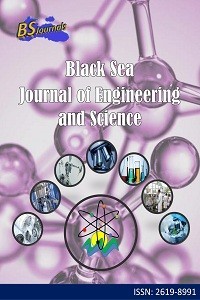Determination of the most appropriate regression method to estimate metabolic energy values by in vitro gas production technique
Determination of the most appropriate regression method to estimate metabolic energy values by in vitro gas production technique
Estimation of metabolic energy values of feeds using in vitro gas production values is an essentialissue in practice. It is determined that estimation of metabolic energy values with lonely use of in vitro gasproduction was not achieved in previous studies. In this study, to determine the most fitted regression model forestimating metabolic energy with use of gas production in certain incubation periods and parameters of gasproduction equation, models were set taking into account distributions of data and models were compared withthe criteria of determination coefficient and mean square error. It is indicated that in vitro gas production valueshave long tailed, skewed, distributions such as Burr, Dagum and Generalized Pareto distribution. As a result, fivedifferent models with high coefficient of determination were set to estimate metabolic energy from in vitro gasproduction using normalized data. The model which estimates the metabolic energy with use of only gasproduction at 24 hours was determined as the best model from these five. Models were simplified to provideconvenience to users when they use models to estimate metabolic energy.
Keywords:
Gas production values, Metabolizable energy Regression, Distribution,
___
- Abaş İ, Özpinar H, Kutay HC, Kahraman R, Eseceli H. 2005. Determination of the metabolizable energy (ME) and net energy lactation (NEL) contents of some feeds in the Marmara region by in vitro gas technique. Turk J Vet Anim Sci, 29 (3): 751-757.
- Ali R, Mlambo V, Mangwe MC, Dlamini BJ. 2015. Chemical composition, nitrogen degradability and in vitro ruminal biological activity of tannins in vines harvested from four tropical sweet potato (Ipomoeabatatas L.) varieties. J Anim Physiol An N, 100(1): 61-68.
- Arı A, Önder H. 2013. Regression models used for different data structures. Anadolu J Agr Sci, 28(3): 168 – 174.
- Aydın D, Kamalak A, Canbolat Ö, Atalay Aİ. 2010. The possibility of use of feces instead of rumen fluid in the in vitro gas production technique, KSU J Nat Sci 13(1): 18 – 25.
- Beuvink JM, Kogut J. 1993. Modeling gas production kinetics of grass silages incubated with buffered ruminal fluid. J Anim Sci, 71(4): 1041-1046.
- Boga M, Yurtseven S, Kilic U, Aydemir S, Polat T. 2014. Determination of nutrient contents and in vitro gas production values of some legume forages grown in the Harran plains a line soils. Asian Australas J Anim Sci, 27(6): 825-831.
- Canbolat Ö. 2012. Comparison of in vitro gas production, organic matter digestibility, relative feed value and metabolizable energy contents of some cereal forages. Kafkas Univ Vet Fak Derg, 18(4): 571-577.
- Geerkens CH, Schweiggert RM, Steingass H, Boguhn J, Rodehutscord M, Carle R. 2013. Influence of apple and citrus pectins, processed mango peels, a phenolic mango peel extract, and gallic acid as potential feed supplements on in vitro total gas production and rumen methanogenesis. J Agric Food Chem, 61(24): 5727-5737.
- Kamalak A. 2005. Comparison of gas production parameters and metabolizable energy contents of some forages. KSU J Sci Eng, 8(2): 116 – 120.
- Kılıç Ü, Sarıçiçek BZ. 2006. Factors affecting the results of gas production technique. Hay Üret, 47(2): 54-61.
- Kılıç U, Boga M, Gorgulu M, Șahan Z. 2011. The effects of different compounds in some essential oils on in vitro gas production. J Anim Feed Sci, 20(4): 626-636.
- Kleinbaum DG, Kupper LL, Nizam A, Muller KE. 1998. Applied regression analysis and other multivariable methods. Duxbury Press, Pacific Grove.
- Menke KH, Raab L, Salewski A, Steingass H, Fritz D, Schneider W. 1979. The estimation of the digestibility and metabolizable energy content of ruminant feeding stuffs from the gas production when they are incubated with rumen liquor in vitro. J Agric Sci, 93(01): 217-222.
- Mirzaei-Aghsaghali A, Maheri-sis N, Mansouri H, Razeghi ME, Safaei AR, Aghajanzadeh-Golshani A, Alipoor K. 2011. Estimation of the nutritive value of tomato pomace for ruminant using in vitro gas production technique. Afr J Biotechnol, 10(33): 6251-6256.
- Razalı NM, Wah YB. 2011. Power comparison of Shapiro-Wilk, Kolmogorow-Smirnov, Lilliefors and Anderson-Darling tests. J of Stat Modelg Anal, 2(1): 21 – 33.
- Sarıçiçek BZ, Kılıç Ü. 2011. Effect of different additives on the nutrient composition, in vitro gas production and silage quality of alfalfa silage. Asian J Anim Vet Adv, 6(6): 618 – 626.
- Şahin M, Üçkardeş F, Canbolat O, Kamalak A, Atalay A. 2011. Estimation of partial gas production times of some feedstuffs used in ruminant nutrition. Kafkas Univ Vet Fak Derg, 17(5): 731-734.
- SPSS: Windows user’s guide. Version 13.0, SPSS Inc., Michigan Ave., Illinois, USA., Chicago, (Access date: 22 June 2014).
- Zhang, T, Zhang Q, Wang Q. 2014. Model detection for functional polynomial regression. Comput Stat Data An, 70: 183-197.
- Yayın Aralığı: 6
- Başlangıç: 2018
- Yayıncı: Uğur ŞEN
